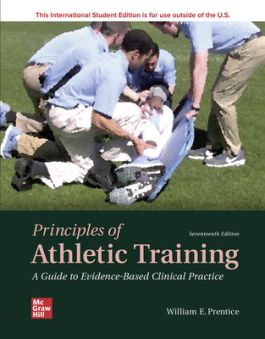Principles of Athletic Training ISE
To access your eBook, sign in or register at McGraw Hill Bookshelf and you will be instructed to enter your access code.
After adding your eBook to the McGraw Hill Bookshelf, download the ReadAnywhere app on the App Store or Google Play. Sign into your McGraw Hill Bookshelf or Connect account to access your eBook on the go and download chapters for offline reading.
For McGraw Hill eBook & ReadAnywhere support, click here.
PART I: Professional Development and Responsibilities
Chapter 1: The Athletic Trainer as a Health Care Provider
Historical Perspectives
Sports Medicine and Athletic Training
Employment Settings for the Athletic Trainer
Roles and Responsibilities of the Athletic Trainer
Referring the Patient to Other Medical and Nonmedical Support Services and Personnel
Recognition and Accreditation of the Athletic Trainer as an Allied Health Professional
Requirements for Certification as an Athletic Trainer
State Regulation of the Athletic Trainer
Future Directions for the Athletic Trainer
Summary
Websites
Chapter 2: Health Care Organization and Administration in Athletic Training
Establishing a System for Athletic Training Health Care
Issues Specific to Athletic Training Program Operation in the Secondary-School, College, or University Setting
Issues Specific to Athletic Training Program Operation in the Clinic, Hospital, Corporate, or Industrial Setting
Record Keeping
The Computer as a Tool for the Athletic Trainer
Collecting Injury Data
Summary
Chapter 3: Legal Concerns and Insurance Issues
Legal Concerns for the Athletic Trainer
Insurance Considerations
Third-Party Reimbursement
Summary
Websites
PART II: Risk Management
Chapter 4: Fitness and Conditioning Techniques
The Relationship between Athletic Trainers and Strength and Conditioning Coaches
Principles of Conditioning
Warm-Up and Cooldown
Cardiorespiratory Endurance
The Importance of Muscular Strength, Endurance, and Power
Improving and Maintaining Flexibility
Fitness Assessment
Periodization in Conditioning
Summary
Websites
Chapter 5: Nutrition and Supplements
Nutrition Basics
Energy Sources
Regulator Nutrients
Nutrient Requirements and Recommendations
Dietary Supplements
Eating and Drinking Practices
Glycogen Supercompensation
Body Composition and Weight Control
Summary
Websites
Chapter 6: Environmental Considerations
Hyperthermia
Hypothermia
Altitude
Overexposure to Sun
Lightning Safety
Air Pollution
Circadian Dysrhythmia (Jet Lag)
Synthetic Turf
Summary
Websites
Chapter 7: Protective Equipment
Safety Standards for Sports Equipment and Facilities
Legal Concerns in Using Protective Equipment
Equipment Reconditioning and Recertification
Using Off-the-Shelf versus Custom Protective Equipment
Head Protection
Face Protection
Neck Protection
Trunk and Thorax Protection
Lower-Extremity Protective Equipment
Elbow, Wrist, and Hand Protection
Construction of Protective and Supportive Devices
Summary
Websites
Chapter 8: Wrapping and Taping
Wrapping
Nonelastic and Elastic Adhesive Taping
Common Taping Procedures
Kinesio Taping
Summary
Websites
PART III: Pathology of Sports Injury
Chapter 9: Mechanisms and Characteristics of Musculoskeletal and Nerve Trauma
Mechanical Injury
Musculotendinous Unit Injuries
Synovial Joint Injuries
Bone Injuries
Nerve Trauma
Body Mechanics and Injury Susceptibility
Summary
Websites
Chapter 10: Tissue Response to Injury
The Healing Process
Soft-Tissue Healing
Bone Healing
Pain
Summary
Websites
PART IV: Management Skills
Chapter 11: Psychosocial Intervention for Sports Injuries and Illnesses
The Psychological Response to Injury
The Athlete and the Soci
A Doody's Core Title for 2015!
Principles of Athletic Training: A Competency-Based Approach is designed to be used by athletic trainers in courses concerned with the scientific, evidence-based and clinical foundations of athletic training and sports medicine. The text leads the student from general foundations to specific concepts relative to injury prevention, evaluation, management, and rehabilitation. As the student progresses from beginning to end, he or she will understand the complexities of the profession of athletic training. An over-arching goal of the text is to make certain that each and every one of the educational competencies identified by the Education Council is specifically covered. After using this text the student should be able to apply the appropriate techniques and concepts in the day-to-day performance of his or her job as an athletic trainer.
McGraw-Hill Connect® is a subscription-based learning service accessible online through your personal computer or tablet. Choose this option if your instructor will require Connect to be used in the course. Your subscription to Connect includes the following:
• SmartBook® - an adaptive digital version of the course textbook that personalizes your reading experience based on how well you are learning the content.
• Access to your instructor’s homework assignments, quizzes, syllabus, notes, reminders, and other important files for the course.
• Progress dashboards that quickly show how you are performing on your assignments and tips for improvement.
• The option to purchase (for a small fee) a print version of the book. This binder-ready, loose-leaf version includes free shipping.
Complete system requirements to use Connect can be found here: http://www.mheducation.com/highered/platforms/connect/training-support-students.html
McGraw Hill Connect is an award-winning digital teaching and learning solution that empowers students to achieve better outcomes and enables instructors to improve course management efficiency.
High-Quality Course Material
Our trusted solutions are designed to help students actively engage in course content and develop critical higher-level thinking skills while offering you the flexibility to tailor your course to the ways you teach and the ways your students learn.
Assignments & Automatic Grading
Connect features a question bank that you can select from to create homework, practice tests and quizzes. Dramatically reduce the amount of time you spend reviewing homework and grading quizzes, freeing up your valuable time to spend on teaching.
Analytics & Reporting
Monitor progress and improve focus with Connect’s visual and actionable dashboards. Reports are available to empower both instructors and students with real-time performance analytics.
Seamless Integration
Link your Learning Management with Connect for single sign-on and gradebook synchronization, with all-in-one ease for you and your students.


